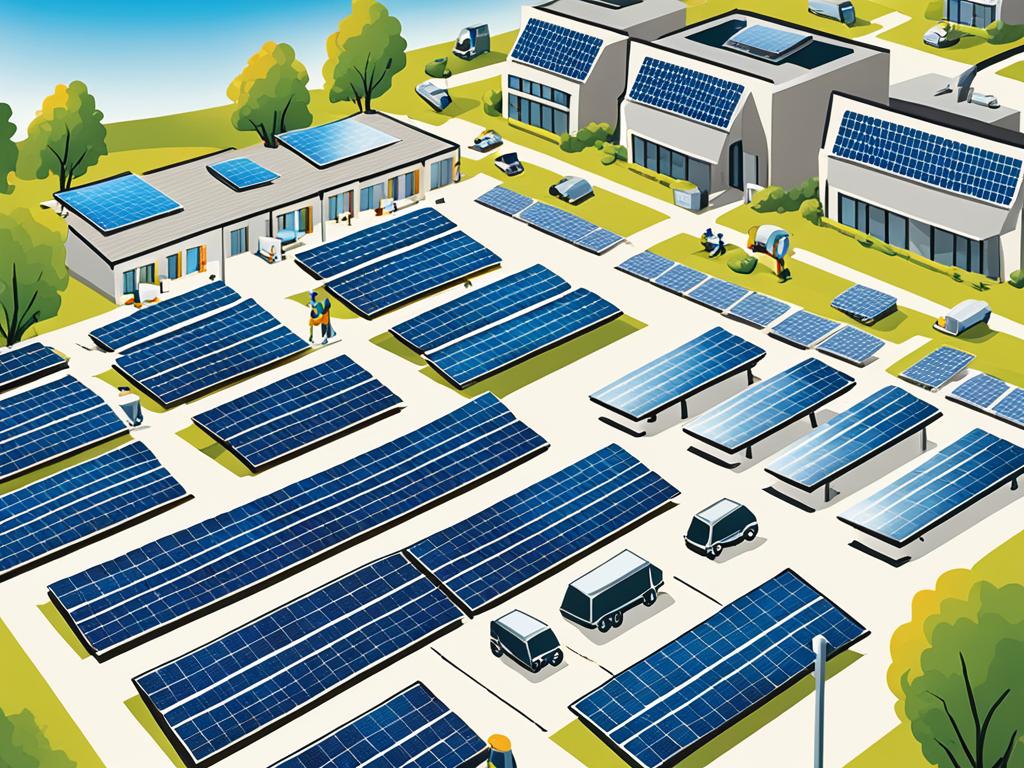Advantages of Lithium Polymer Batteries Over Traditional Cells: A Detailed Look
Discover why lithium polymer battery technology leads with its superior energy density, lightweight design, and long-lasting power capacity.

The search for better power solutions never ends. It leads us to push the limits of battery technology. The lithium polymer battery stands out as a key innovation, aiming to change how we use energy. But why is it better than other batteries?
In India, the need for efficient energy is huge because of fast technology growth. Fenice Energy is exploring the benefits of lithium polymer batteries. They’re making our devices lighter yet just as powerful.
Lithium polymer batteries pack a lot of power and don’t need much upkeep. They support the push for more battery technology that’s both reliable and eco-friendly.
Key Takeaways
- Lithium polymer batteries offer a high energy density, making them powerful yet lighter alternatives to traditional batteries.
- The technology behind lithium polymer batteries allows for greater design flexibility, fostering innovation in device manufacturing.
- Fenice Energy’s dedication to advanced power solutions includes leveraging lithium polymer batteries for their clean energy systems.
- Maintenance-free with a low self-discharge rate, these batteries offer efficient energy usage with prolonged lifespans.
- The potential of lithium polymer batteries lies not only in consumer electronics but also in applications like solar power and electric vehicles (EVs).
- Understanding the advantages and applications of lithium polymer batteries can lead to more informed decisions about energy consumption and storage.
- As India moves towards greener initiatives, the role of efficient and lightweight energy sources like lithium polymer batteries becomes crucial.
Introduction to Lithium Polymer Battery Technology
Lithium polymer battery technology is changing the game in rechargeable batteries. Known for high energy and efficiency, these batteries are leading in portable power. They use a gel-like electrolyte, moving from liquid to a conductive semi-solid state.
Lithium polymer cells are key for compact, powerful energy solutions. They power light devices like drones, smartphones, and more. This technology boosts power and reduces weight, improving devices used by companies including Hyundai and Kia.
- Energy Density: Offering energy densities between 250 and 670 W·h/L, lithium polymer batteries ensure a longer-lasting charge in smaller packages.
- Cycle Life: These cells are engineered for longevity with a low self-discharge rate of approximately 5% per month, further solidifying their position in the market and in companies like Fenice Energy’s comprehensive clean energy solutions.
- Safety: LiPo batteries incorporate safety valves and PTC components, highlighting their advanced safety features suited for consumer electronics and UPS systems.
- Innovation: Paving the way for ultra-lightweight, thin notebooks, and mobile devices, they have carved a niche in creating portable devices without compromising on power.
Inside, lithium polymer batteries have a spiral design. This maximizes space and ensures a uniform layer between electrodes for better performance. This structure supports higher voltages in devices like portable jump starters, now preferring LiPo cells.
| Feature | Advantage | Application |
|---|---|---|
| Enhanced Energy-to-Weight Ratio | Lightweight design for heavier-duty applications | EVs and large-scale model trains |
| Low Self-Discharge | Maintains charge over extended periods | Backup power for UPS systems |
| Flexible Form Factor | Customizable shapes for diverse devices | Tablets and wearable technology |
| High Usable Energy | Optimal power delivery in emergencies | Battery jump starters |
Fenice Energy is leading in clean energy systems, thanks to lithium polymer technology. They predict a 15% yearly growth in Li-battery sales until 2024. Fenice integrates LiPo batteries into solar solutions and electric vehicles, meeting UL 1642 standards.
Learning from pioneers like Sony and Ericsson, Fenice Energy aims to innovate. They focus on sustainable, portable, and powerful solutions with lithium polymer technology.
High Energy Density: Revolutionizing Portable Power
Lithium polymer batteries are crucial in today’s quest for efficient energy. They offer high energy density and power up lots of portable devices. Fenice Energy is at the forefront, using these lightweight batteries for both sustainable and reliable power solutions.
The Superior Power-to-Weight Ratio of LiPo Cells
Lithium polymer batteries pack a lot of energy, with densities between 100 to 265 W·h/kg. Their excellent power-to-weight ratio sets them apart. They empower slimmer, more powerful devices. Fenice Energy leverages this for longer-lasting, better-performing products.
Impact of High Energy Density on Device Longevity and Usage
Lithium polymer technology has evolved, allowing for custom battery sizes and higher safety. They adhere to international standards like UN 38.3 and IEC 62133. Fenice Energy commits to safe, efficient portable power solutions with these advancements.
Fenice Energy boosts lithium polymer batteries’ impact in clean energy. They use custom batteries with various setups for different needs. Their long cycle life and lightweight design enhance efficiency in electric vehicles and renewable energy storage. This supports the push for a more sustainable energy future.
The Evolution and Design of Modern Lithium Polymer Batteries
The lithium polymer battery is key in battery technology. Its design marks significant progress in energy storage. From its start to today, there’s a clear focus on better performance and versatility. This change is led by the use of a polymer electrolyte, bringing safety, reliability, and many design options.
Fenice Energy notes the big influence of lithium polymer batteries in cars and transportation. Here, they meet 98% of the needs for new batteries. Their energy and power density are crucial for electric vehicles (EVs) and energy storage.
This battery technology has grown due to its high energy and density. This growth meets the growing demand from the EV market in India. Choosing the right cathode and anode materials is key. It impacts energy levels and how long vehicles can go and how fast they charge.
- Cycle Life: Lithium polymer batteries are adaptable. They are cost-effective over time. For instance, Lithium Cobalt Oxide (LiCoO2) cathodes last for 500–1000 cycles.
- High Energy Cathodes: The search for better cathodes has led to Lithium Manganese Oxide (LiMn2O4) and Lithium Nickel Manganese Cobalt Oxide (LiNiMnCoO2). These are used in everything from gadgets to EV powertrains.
- Technical Safety: With these advances come challenges, especially in safety. High energy density and quick charging need care. Using Silicon in anodes and more nickel in cathodes can help balance capacity with safety.
These advancements highlight the ongoing improvement of lithium polymer batteries. Fenice Energy uses its 20 years of experience to offer renewable energy solutions. These are not just for the future but also meet today’s needs in India’s clean energy sector.
The balance between power and safety is crucial in new battery designs. There’s a strong focus on cost, lifetime, and being eco-friendly. The future of battery technology looks strong, ready to meet India’s complex energy needs and more.
Efficient Energy Storage: LiPo’s Advantage in Rechargeability
The world of rechargeable batteries is changing fast. Lithium polymer (LiPo) batteries are leading the way. They have a long cycle life, which makes them great for many uses.
Looking into LiPo batteries, we see why they’re a top choice for storing energy. People pick them for their efficient rechargeability.

Extended Cycle Life Compared to Traditional Batteries
LiPo batteries last a lot longer than usual ones, with 400 to 1,200 cycles. This makes them better for the planet and saves money. Fenice Energy uses them to make renewable energy that’s dependable.
Retention of Capacity Over Numerous Charge Cycles
Many rechargeable batteries lose power fast. But LiPo batteries don’t. They keep much of their power even after many charges.
This quality makes them a smart, money-saving option for Fenice Energy’s projects, like solar systems and electric cars.
Here are some key facts about LiPo batteries and how good they are for storing energy:
| Characteristic | Value | Unit | Remarks |
|---|---|---|---|
| Specific Energy | 100 – 265 | W⋅h/kg | Essential for weight-sensitive applications |
| Energy Density | 250 – 693 | W⋅h/L | Higher density enables compact sizes |
| Specific Power | 250 – 340 | W/kg | Indicative of robust power output |
| Charge/Discharge Efficiency | 80 – 90 | % | Reflects high energy utilization rate |
| Energy to Consumer-Price Ratio | 7.6 Wh/INR | (INR₹10,632/kWh) | Cost-effectiveness benchmark |
| Self-Discharge Rate per Month | 0.35 – 2.5 | % | Low rate enhances storage efficiency |
| Global Li-ion Production Capacity (2020) | 767 | GWh | Dominated by production in China |
Fenice Energy blends these effective storage solutions into its work. This lets customers enjoy LiPo batteries’ lasting power and reliability.
Lithium Polymer Battery: A Lightweight Solution
The search for portable, efficient power sources is crucial today. Lithium polymer batteries shine in this area due to their lightness and strength. They’re notably lighter compared to other batteries.
First used in early mobile tech and laptops, these batteries are known for being tough and leak-resistant. Fenice Energy uses this tech for better power solutions. This makes devices smaller and electric vehicles slimmer without losing power.
Here are some key points about lithium polymer batteries:
- They are light and flexible, so they fit various devices.
- A full charge takes only 1-2 hours, offering quick power recovery.
- They’re bigger than lithium-ion batteries but have a high power capacity. This makes them versatile for different uses.
- Prices range from Rs. 2250 to Rs. 1.5 lakhs, showing their value and advanced features.
- They last up to 1500 charge cycles at 95 amps, surpassing many lithium-ion batteries.
- Tesla and others are working on Solid State Batteries for more compact, lasting solutions.
Lightweight and tough, lithium polymer batteries are ideal for India’s growing electronic and car markets. Fenice Energy focuses on making batteries that are light yet powerful. This supports the development of lighter electric vehicles and portable electronics for a greener future.
“The integration of lithium polymer batteries into clean energy solutions is shaping a future where power does not weigh us down but propels us forward.”
Lithium polymer batteries perfectly blend power, portability, and sustainability. Their long standby time and high voltage capacity serve diverse devices well. This makes them a key player in mixing innovation and practicality.
Advanced Power Solutions Enabled by LiPo Battery Flexibility

The lithium polymer battery is not just special for its chemistry. It also shines because of its shape flexibility. This flexibility has led Fenice Energy to use polymerelectrolyte technology. Their batteries meet the varied needs of clients. We see these in sleek gadgets and in efficient, clean energy solutions. The ability to customize LiPo batteries means creative and practical power solutions.
The Creative Shaping Potential of Polymer-Based Power
The malleability of lithium polymer batteries is a game-changer. Their pouches can “shape-shift” to fit any device. This allows for thinner gadgets and more comfortable designs. The blend of form and function has never been easier.
Customization for Specific Application Needs
Fenice Energy focuses on customizable power solutions. They know that each gadget has its own energy needs. So, they use LiPo batteries’ flexibility to create perfect energy solutions. These solutions are for everything from tiny satellites to trendy wearable tech. They ensure devices work their best.
| Technology Evolution | Advantages | Applications |
|---|---|---|
| Lithium-ion Batteries (1991) | Started the shift towards portable and powerful energy storage | Consumer Electronics |
| Integration of Polymer Electrolytes (Late 1990s) | Improved safety and performance, faster charge-discharge cycles | Clean Energy Systems |
| Gel-Based Polymer Electrolytes | Enhanced conductivity and stability | Electric Vehicles, Nanosatellites |
| PEO:Li Polymer Electrolytes (Armand, 1970) | Increased energy density and efficiency for advanced demands | Deep-space Exploration |
| Solid Polymer Electrolytes (SPEs) and Gel Polymer Electrolytes (GPEs) | Flexibility in application due to customizable shapes and sizes | Wearable Tech, Portable Devices |
Improving Safety with Lithium Polymer Batteries
The lithium polymer battery technology brings a new level of improved battery safety and reliability. Fenice Energy is at the forefront, focusing on how these batteries make our power storage and use safer. It’s crucial for the future of clean energy solutions.
Gel electrolytes push lithium polymer batteries’ safety further. They provide a stable structure that cuts down on leaks and the chance of fires. Also, gel electrolytes help these batteries maintain a safer, more reliable form.
Reducing Risks with Gel Electrolytes and Polymer Components
Fenice Energy uses gel electrolytes to make their lithium polymer batteries safer. They’re focused on safety as much as they are on performance. This means fewer issues with overcharging, short circuits, and overheating.
Advanced Circuitry to Mitigate Overcharging and Thermal Issues
With modern circuitry, lithium polymer batteries prevent overcharging. These safety features help the batteries last longer. Fenice Energy’s focus on these safety steps shows a move towards less risk in energy storage.
Lithium polymer batteries are known for their stability and efficiency. Their energy can range from 100 to 265 W⋅h/kg. And they have a high energy density. They don’t waste much energy either, losing only 0.35% to 2.5% of their charge per month.
The progress in lithium polymer battery technology marks a big step in safety and quality. Fenice Energy’s use of these batteries shows they’re looking ahead. They want a future with safer, greener power systems.
Applications Across Industries: Lithium Polymer Batteries in Action
Lithium polymer batteries are changing many areas, like consumer electronics and cars, especially electric vehicles (EV). These batteries make devices powerful yet thin. As more people want green transport, EV battery performance becomes vital. Lithium polymer batteries are key to this change.

Transforming Consumer Electronics with Slimmer, More Powerful Devices
Lithium polymer battery use has made consumer electronics thinner and stronger. In India, companies like Fenice Energy meet the demand for compact tech with clean energy solutions. They have 20 years of experience.
Empowering Automotive Innovation with Enhanced EV Battery Performance
The car industry is evolving with more electric vehicles on the roads. Lithium polymer batteries offer high energy but are light. This is important in India where green tech is a focus. Fenice Energy supports greener cars with these batteries.
In consumer electronics, these batteries power everything from phones to laptops. They also help electric vehicles charge faster and go further. This is thanks to improvements in EV battery performance.
The spread of lithium polymer batteries shows a commitment to a greener future. They are not just a trend but a promise for better sustainability and innovation.
Conclusion
The world of battery tech has been changed by lithium polymer batteries. They meet the need for high energy storage efficiently. These batteries are key for many gadgets, like phones and electric cars. This is due to their light weight and super slim design.
Fenice Energy has used these batteries for over twenty years to address India’s growing need for energy. Lithium polymer and Li-ion batteries are crucial in electronics and clean energy. They are seen as safe under standards such as UL 1642. Their stable voltage and low explosion risk make them popular. Compared to Li-ion, LiPo batteries charge faster and last longer which makes them worth the cost.
Looking ahead, lithium polymer batteries align with goals of sustainability and efficiency. Fenice Energy follows these same principles. This blend of demand and technology points to a future where devices are not just powered well but smarter. Lithium polymer batteries will keep playing a key role, leading us to a greener future.


